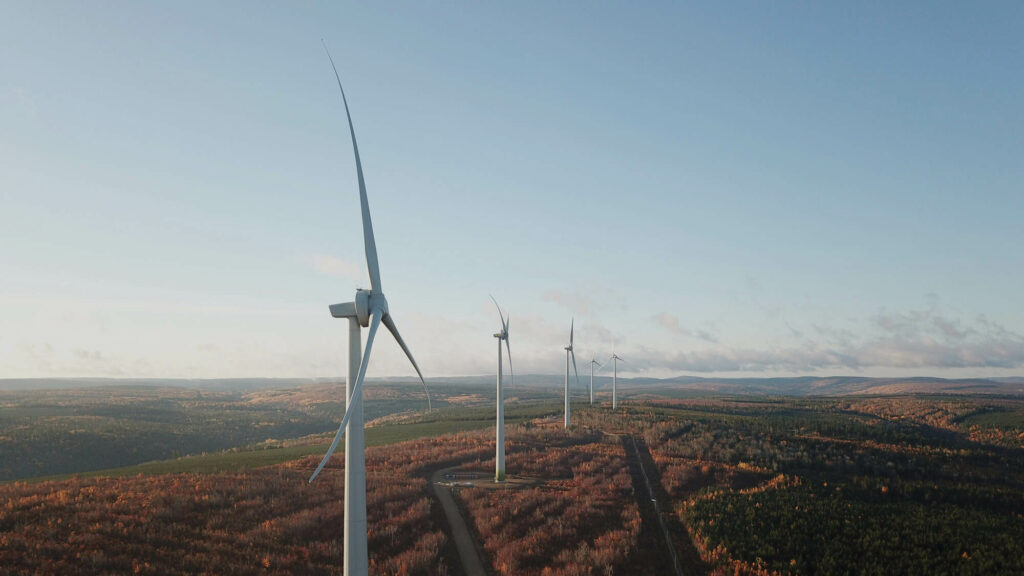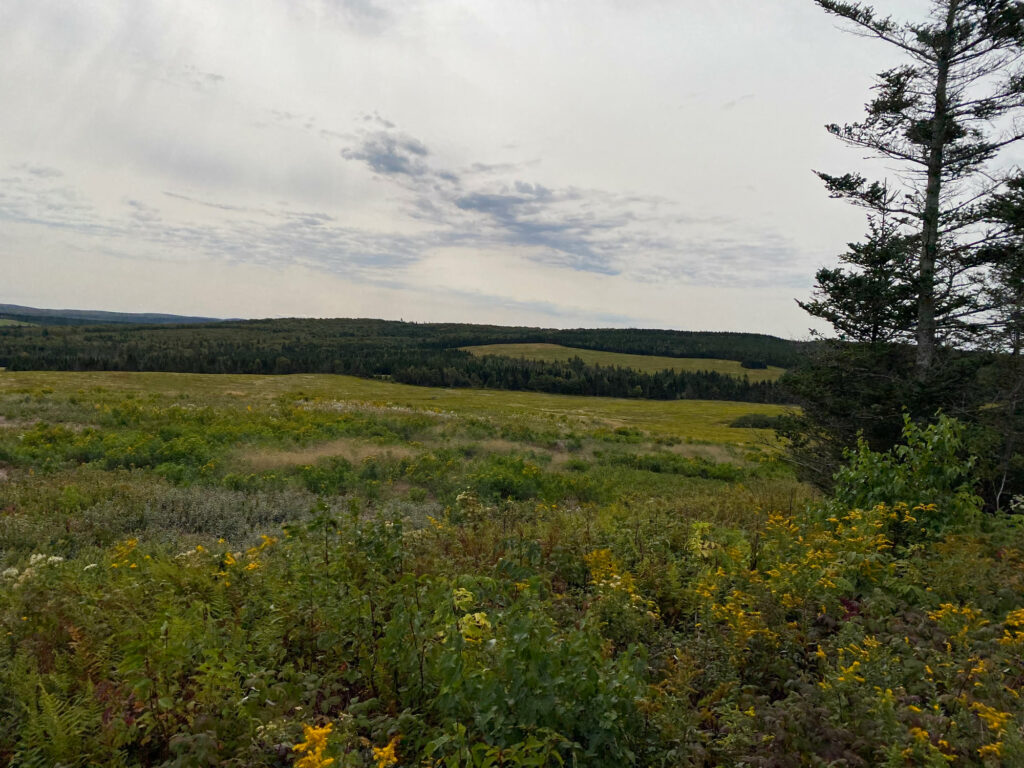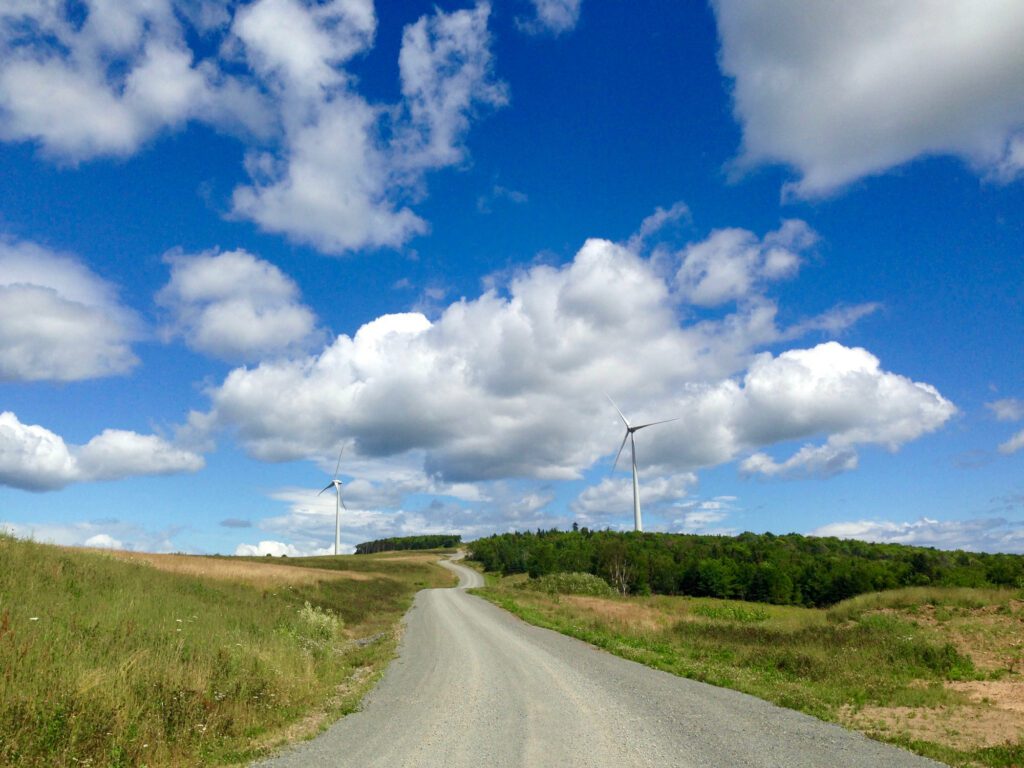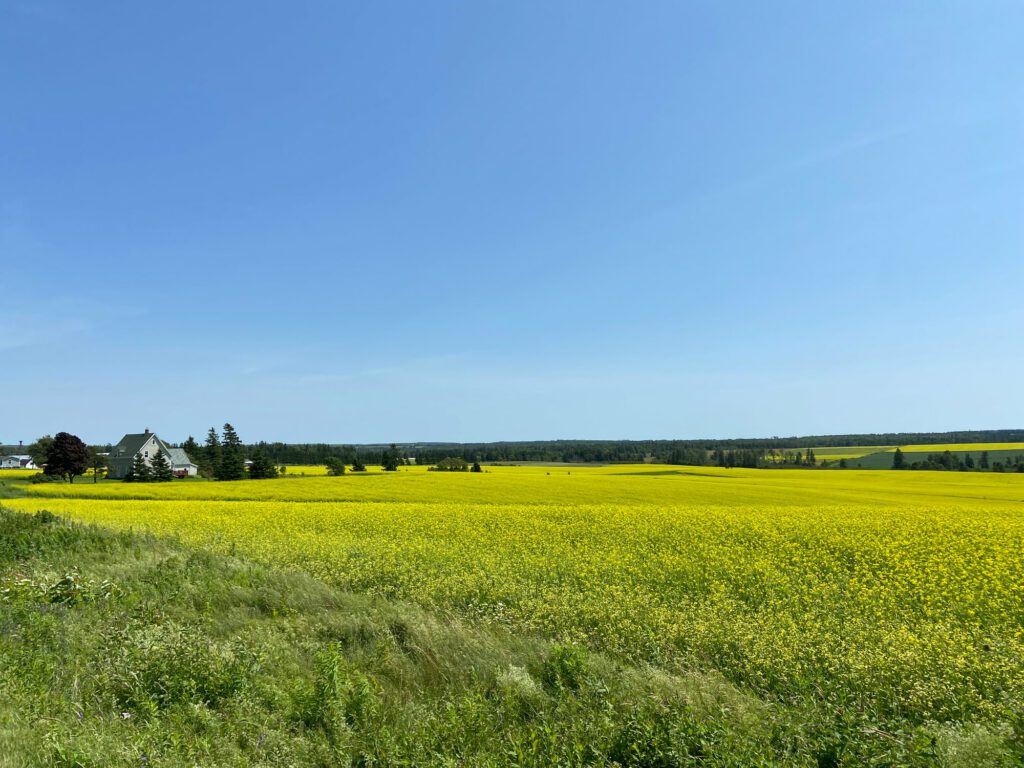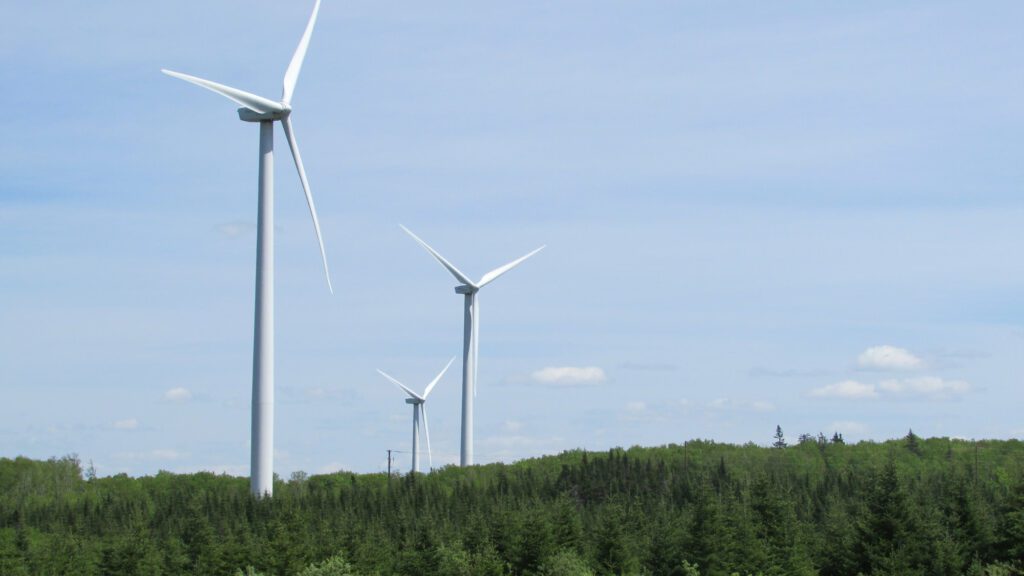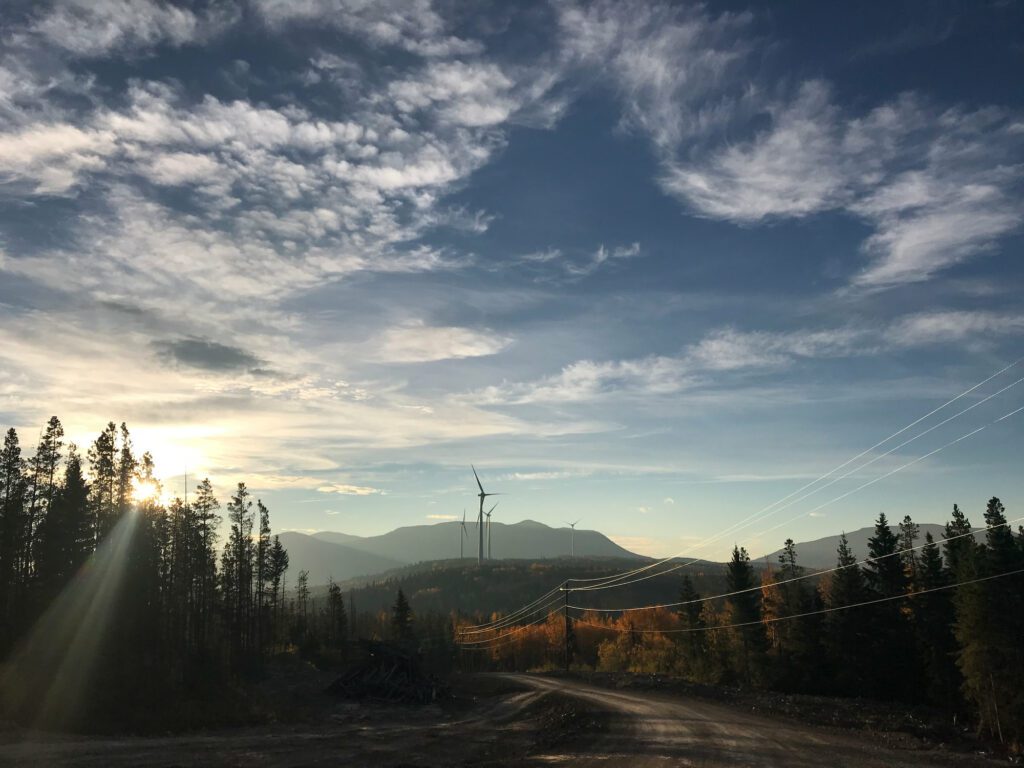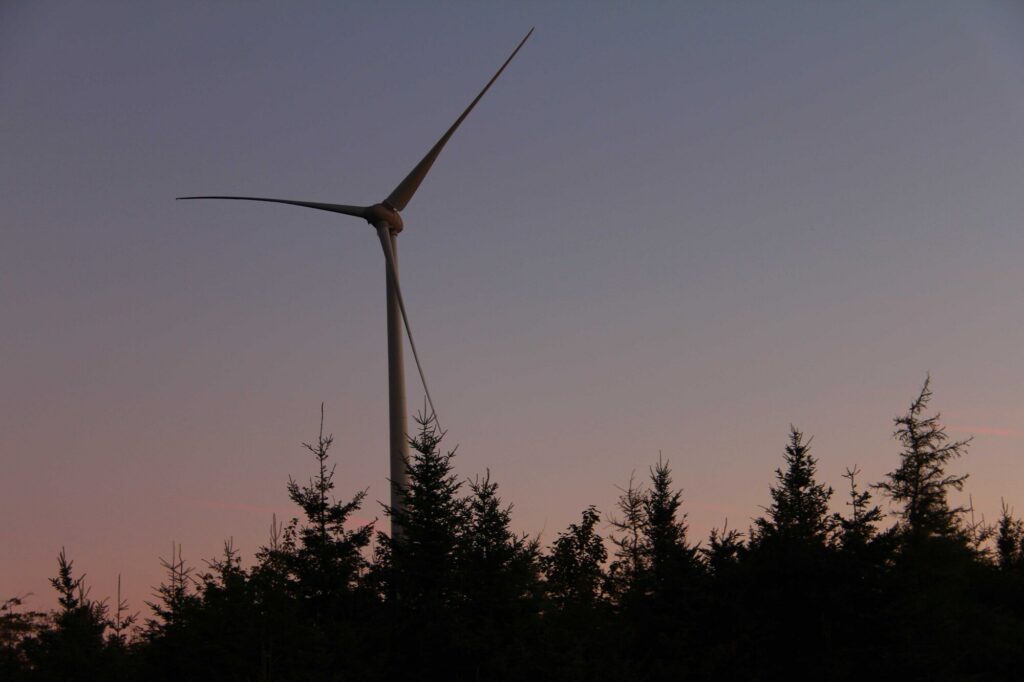Welcome to the official Wocawson Energy Project webpage!
This webpage has been created to provide information about the Project to the community, stakeholders, and the First Nations of New Brunswick.
Wocawson Energy Project is now operational!
About The Project
The Wocawson Energy Project is located in Kings County, New Brunswick approximately 20 kilometers northeast of the Town of Sussex. The site lies between Route 114 and Portage Vale on Provincial Crown Land. The Wocawson Energy Project will consist of 5 turbines with an installed capacity of 20 MW being built. Phase 1 of this project became operation in December, 2020. There is an optional phase 2 to the project that may consist of an additional 5 turbines and 20 MW, this has been permitted but there is no immediate timeline or plans for this second phase.
This capacity is estimated to supply approximately 5,000 homes with electricity while offsetting 22,000-44,000 tonnes of carbon dioxide annually. The proposed project layout can be viewed in the document below. Note that the expansion turbines are subject to change should that phase of the project move forward in the future.
The selected turbine for this project is the Enercon E-126 Wind Turbine.
What’s Happening
December 2020:
- Site became fully operational and is now supplying power to the NB Power Grid!
November 2020
- Trial Operation for T1 and T2
- Commissioning for T3 and T5
October 2020
- Construction is now completed for three turbines (T3, T4, and T5), and trial operation has begun (they have started spinning!)
- Turbine T2 is in the commissioning process and T1 is being connected to the grid
August 2020
- Assembly complete for turbines T5 and T4, including tower, nacelle, rotor, hub, and blades
- Assembly ongoing for turbine T2 and T3, including tower, nacelle, rotor, hub, and blades
- Pre-assembly has begun for turbine T1
- Tobique First Nation artists on site painting turbine nacelles
July 2020
- Turbine pre-assembly and assembly activities
- Tobique First Nation artists on site painting turbine nacelles
June 2020
- Delivery of turbine tower sections to site begins
- Pre-assembly of turbine tower sections
May 2020
- Mobilization of ENERCON to site prepare for turbine installation
April 2020
- Energization of transmission line and substation
- Arrival of many turbine components to Port Saint John, including the blades
August 2019
- Installation of ice warning lights
- Substation work continues with wiring and cable installation
- Concrete pouring for the final turbine foundation
- Framing for the collector system
- Installation of the transmission line is complete and the NB Power team is demobilizing from site
- Completion of cleaning up the transmission line construction work
- Water quality monitoring
- Installation of the transformer for the substation
July 2019
- Substation work continues with installation of fencing, control buildings, and components
- Installation of poles and stringing of the wires for the transmission line
- Rebar work for turbine foundations
- Concrete pouring for turbine foundations.
- Water quality monitoring
June 2019
- Excavation for the turbine foundations
- Pouring of mud slabs for turbine foundations
- Rebar work for turbine foundations
- Concrete pouring for turbine foundations
- Installation of transmission line poles, including framing, insulators, and wire stringing
- Road work is complete
- Steel work at the substation is complete
- Work on the snowmobile trail
- Water quality monitoring
May 2019
- Excavation for the turbine foundations
- Pouring of mud slabs for turbine foundations
- Crane pad construction
- Upgrading and widening existing roads on site
- Reinforced steel bars (rebar) installation and concrete works for the substation
- NB Power working on the transmission line
- Water quality monitoring
April 2019
- Upgrading existing roads on site
- Construction of new spur roads to access turbine crane pads and lay-down areas for the turbine components
- Excavation for the substation and turbine foundations
- Pouring of mud slabs for turbine foundations
- Water quality monitoring
March 2019
- Provincial Environmental Impact Assessment approval
- Construction activities commence onsite, beginning with tree clearing
- Water quality monitoring in water courses near the project activities
Who is proposing this project?
This project is being proposed by the Wocawson Energy Limited Partnership, a partnership formed between Tobique First Nation and Natural Forces.
Tobique First Nation is one of six Wolastoqiyik Nation reserves in New Brunswick, Canada. Tobique is the largest of the Wolastoqiyik Nation reserves in NB with a total population of approximately 2,500. The Tobique Reserve is located on the north side of the Tobique River. Administration of Tobique is led by Chief Ross Perley along with 12 Councilors.
Natural Forces is a successful regional energy developer based out of eastern Canada, who have successfully developed, constructed, and currently operate multiple wind projects in Atlantic Canada for over a decade. Natural Forces has been working in New Brunswick since 2001 and were successful in both the 2006 and 2008 calls for power which resulted in the construction of the 150 MW Kent Hills wind farm in partnership with TransAlta. Visit our website at www.naturalforces.ca or contact us at 902-422-9663 to learn more about us and our projects.
In the media
You can listen to Chief Ross Perley from Tobique First Nation and Andy MacCallum, VP of Development with Natural Forces, answering questions regarding the Wocawson Energy Project in an interview with CBC radio here.
Why Here?
When developing a wind project, it is crucial to find the best suitable location and community to host it. To do so, there are four main factors to consider during the site finding phase of development:
- Wind resource
- Distance to existing electrical and civil infrastructure
- Environmental sensitivity
- Socio-economic concerns
Wind resource:
To measure the wind resource, a temporary meteorological mast or ‘met mast’ was installed on the project site in May 2017. The met mast is equipped to measure the wind speed, wind direction, temperature and relative humidity. From the initial review of the data, the location is showing a favorable wind resource.
Distance to existing electrical and civil infrastructure:
The project is located between Route 114 and Portage Vale where current forestry activities exist. As such, we intend to make use of the existing forestry roads to access the project site. The wind farm electrical lines would likely connect to the existing NB Power lines to the north of the project site near Highway 1.
Environmental sensitivity:
The project is sited outside of any known environmental sensitive areas and field surveys for the Environmental Impact Assessment began in February 2018 and will further assess the sensitivity of the specific project.
Socio-economic concerns:
The proposed project is located on Crown Land in Cardwell Local Service District. The Project site is very rural and located over a kilometer from cabins and homes. The site has previously been disturbed from forestry activities and access roads will make use of existing roads where possible. Photomontages will be created to demonstrate the potential impact of the project on the landscape in the region.
Public Consultation
The development of wind energy in New Brunswick not only provides a clean stable source of electricity to help meet growing energy demands and provincial targets but also provided additional community benefits such as:
- An increase in demand for local goods and services during the feasibility and construction phases of development.
- The creation of jobs within Kings County during the construction phase.
- Partnerships and own source revenue for a local First Nation Community
Natural Forces is excited about the opportunity to work with Tobique First Nation and local residents to develop the Wocawson Energy Project. We are committed to establishing positive relationships with the community by means of public meetings, community consultation, and one-on-one discussions. In doing so, we will do our best to address all concerns pertaining to this proposed development raised by local residents and community members. Natural Forces welcomes and encourages all community members to attend public meetings and engagement events to learn more about the project and to voice any concerns you may have.
What is the process?
1
Development
- Assess the wind resource
- Survey for environmentally sensitive features
- Optimize turbine location to capture the wind efficiently and minimize impact on sensitive features
- Begin consultation with regulators and the public
- Conduct and present the Environmental Impact Assessment for environmental approval
- Apply for road, work and construction permits
2
Construction
- Clear trees for roads and turbine pads
- Build access roads and pad areas
- Pour the turbine foundation
- Assemble the wind turbine
- Connect to NB Power’s electrical grid
3
Operation
(Current Stage)
- Commission the wind turbines to start producing power
- Conduct post-construction wildlife monitoring
- Monitor remotely for real time alerts when additional maintenance is needed
- Operate for 30 years
4
Decommission or Retrofit
- Assess wind turbine after 30 years
- Decommission wind turbines in 3-6 months
- Reclaim the site to its former state OR
- Receive approvals and permits to retrofit the turbine to continue harnessing energy
Environmental Impact Assessment
The New Brunswick Clean Environment Act, Environmental Assessment Regulations states that any wind farm project exceeding 3 MW of installed capacity must undergo an Environmental Impact Assessment (EIA). As the Wocawson Energy Project will produce 20-40 MW of electricity it is subject to an EIA.
To fully assess the potential environmental impacts of the project, comprehensive studies including the following were conducted:
- Wind Resource Assessment
- Bird and Bat Surveys
- Wetlands and Watercourses Surveys
- Vegetation and Habitat Surveys
- Noise and Visual Assessments
- Electromagnetic Interference Assessments
- Archaeological Assessments
Results from these studies were compiled in an EIA document presented to the Province and registered on September 21st, 2018. The EIA was approved on March 12, 2019. Construction is currently ongoing. Please find a copy of the EIA document and Appendices in the attachments below:
- Wocawson Energy Project EIA
- Appendix A: Turbine Model Datasheet
- Appendix B: Noise Impact Assessment
- Appendix C: Shadow Flicker Impact Assessment
- Appendix D: Avian Survey Report
- Appendix E: Bat Survey Report
- Appendix F: Aquatic Habitat Report
- Appendix G: Wildlife and Wildlife Habitat Report
- Appendix H: Vegetation and Habitat Report
- Appendix I: Archaeological Report
- Appendix J: Environmental Management Protection Plan
- Appendix K: Adaptive Management Plan
- Appendix I: Complaint Resolution Plan
- Appendix M: Obtained Permits
On November 27, 2018, the Project layout was revised to consist of a 5 turbine layout (instead of 6) proposed for construction in 2019. We have also finished our fall survey work for the season which included further bird, bat, and archaeological surveys. These reports, along with the new layout have been submitted to the province to be included in the EIA review and can be found below:
- Turbine Layout Addendum
- Fall Bat Surveys
- Archaeological Testing Report
- Transmission Line Access Addendum
- Fall Bird Surveys
Since the original submission of the Environmental Impact Assessment was submitted in 2018, the initial locations proposed for Phase II have been relocated due to additional understanding of the project site and additional regulations from the province. Due to the change in the turbine positions for the Phase II of the project, an addendum to the Environmental Impact Assessment was submitted to the province for review in January 2020. This addendum served to assess the potential environmental impacts of the project at these new locations, the following studies have been completed:
- Bird and Bat surveys
- Wetland and Watercourse surveys
- Vegetation and Habitat Surveys
- Archeological Assessments
On July 27th, 2020 the Phase II Addendum was approved. The addendum to the EIA is attached below:
Wocawson Energy Project EIA Addendum Phase II
For more information on the EIA process, please visit the Department of Environment and Local Governments EIA webpage by clicking here.
Photo Gallery
More pictures will be added here as the project progresses.
Conventional sources of electricity come from burning fossil fuels such as coal, gas, oil and from nuclear fuels. There are fears of fossil fuel shortages, and an international consensus that burning fossil fuels is contributing to our planet’s increasingly rapid climate change.
Power generation from clean energy sources has become increasingly important. To reflect these needs, the Canadian government’s targets seek to increase Canada’s electricity generated by renewable sources to 25% by 2015, and by 40% by 2020. The benefits of wind energy in Canada are extensive:
- New energy generation helps to meet the growing demand for electricity.
- Increased diversity of supply and therefore, increased security of supply.
- Aids in the prevention of biodiversity loss caused by unchecked world temperature rises.
For more information on wind energy in Canada, visit: www.renewablesassociation.ca/.
Frequently Asked Questions
Some people have concerns about the impact of wind farms on house prices, health , and other issues. As a result, many studies have been done with regard to these issues and are available on Government and Industry association websites. Many more facts about Wind Energy can also be found on the CanWEA Wind Facts page (FAQ’s).
Since wind turbines are large mechanical equipment, they can be expected to produce noise. However, as wind turbine technology has evolved, the sound emitted by wind turbines has decreased, In current designs the mechanical noise is almost obsolete, resulting in only the interaction of the air and the turbine parts producing noise. This noise decreases as the radial distance from the turbine increases. To relate this, the compressor of a refrigerator produces 40-45 dB of noise. According to the Government of New Scotia, a wind energy project would have a noise level of between 35-45 dB at 350 meters away (Check out the Energy Nova Scotia Wind Page for more information). Federal and provincial jurisdictions establish minimum distances from turbines to occupied dwellings to minimize this noise.
A study done by Health Canada in 2014 investigated the health effects of wind turbine noise. This study found that wind turbine noise was not associated with self-reported slip, illness or stress levels. The summary of these results can be reviewed on the Health Canada Environmental and Workplace Health page.
Shadow flicker is created when the sun is at a certain angle behind the turbine. When the sun shines through the blades, the movement of the blades can cause a shadow that flickers on and off as the blades rotate onto the land. New Brunswick has identified sector specific guidelines for wind turbines that requires wind energy projects not to exceed 30 minutes/ day or 30 hours/ year of shadow flicker at any receptor and cannot exceed 40 dB[A] of sound at any receptor. From initial assessments, the proposed Wocawson Energy Project is not expected to exceed these thresholds due to the distance from dwellings. The noise threshold of 40 dB[A] is approximately the same loudness as a running computer, refridgerator, or running stream.
The proposed turbines are set back 1.2km from all cabins and houses.
The turbines being considered for this project have a maximum height of 210m to blade tip. Wind turbines have gotten larger over the past few years which allows them to produce more power and reduces the amount of wind turbines needed to meet energy demands. Though these larger turbines are more efficient and reduce the ground disturbance by reducing the amount of turbines needed, they are taller and increase can be seen from further areas surrounding the project. Photomontages will be completed where photos are taken of local areas and with software aid the turbine can be realistically imposed on the photo to provide a general idea of what the landscape will look like once the Project is built.
The project is proposed on Crown Land owned by the Province of New Brunswick. While the project is in operation, the land will still be owned by the province. Wocawson Energy LP will simply obtain a wind power lease over the land in which the turbines are located.
No land will be expropriated from landowners. Natural Forces has many operating windfarms on private lands in Nova Scotia. In these cases, the company has developed, over years, a trusted relationship with the landowners and in all instances, the land still remains in the ownership of the landowner and is leased for the duration of the project. No land has been leased from unwilling landowners. In regards to the Wocawson Energy Project, the majority of the project is located on crown lands except for the proposed transmission line. For this line, New Brunswick Power has initiated notifications and discussions with landowners where the line may cross.
There is always a possibility, however, currently Wocawson Energy LP has signed a 20 MW Power Purchase Agreement with New Brunswick Power. Natural Forces is always happy to hear from landowners who are open to having a Project on their land. If you are interested, you can provide your name and contact information as well as the Property Identification Number for your land. Though there are no new programs open for renewable energy development in New Brunswick, we would be happy to consider your land for future projects.
According to the National Renewable Energy Laboratory and the emissions produced within the New Brunswick Power energy sector, using a very conservative estimate the Wocawson Energy Project is predicted to offset the carbon that may be emitted during its cradle to grave lifecycle within the first year of operation. This allows at least 29 years of operation to offset emissions produced in the New Brunswick electricity sector from fossil fuel emitting sources.
It is estimated that the Wocawson Energy Project will provide up to 115 – 135 construction jobs. These positions will be held by local-subcontractors hired under Natural Forces who will act as General Contractor during the construction phase of the project.
Wocawson Energy LP is aware of that the snowmobile club is one of the biggest land users in the surrounding area and we have been, and will continue to work closely with the Snowmobile Club to ensure impacts to snowmobile trails are minimized.
Thus far, barn owls have not been observed during field surveys. All species that are observed over all survey seasons will be compiled in the registered Environmental Impact Assessment document which will be made available in print near the project site and electronically on the website for review and comment.
The transmission line may cross wetlands and watercourses. These aquatic features will be delineated and monitored by qualified professionals and further analysis of these features will occur for careful micro-siting of Project components. Micro-siting will help avoid these features and ensure impact is minimized to the extent possible.
The turbine model chosen for this project is an Enercon E126-EP3 and will has a capacity of 4.0 MW, which will power approximately 950 homes annually even with periods of low wind. The turbine hub height is 135 m high, and the blade length is approximately 63.5 m long resulting in a maximum height of 198.5m.
Complaint Resolution
Wocawson Energy Limited Partnership has drafted a Complaint Resolution Plan. This Plan identifies the appropriate individual to contact should there be concerns about negative impacts affecting community members or the environment caused by the wind project development. The Complaint Resolution Plan also outlines how complaints will be addressed concerning the Wocawson Energy Project. The activities scoped into the Complaint Resolution Plan include:
- Commercial traffic and noise due to construction activities
- Noise from the operation of the wind farm
- Shadow flicker annoyance
- Bird or bat mortality caused by the wind farm
- Weakening environmental mitigation measures
- Any other annoyances which may result from the wind farm activities, e.g., lighting.
Wocawson Energy Limited Partnership is committed to act diligently to address any concerns raised in a timely manner. You can view the Complaint Resolution Plan below.

